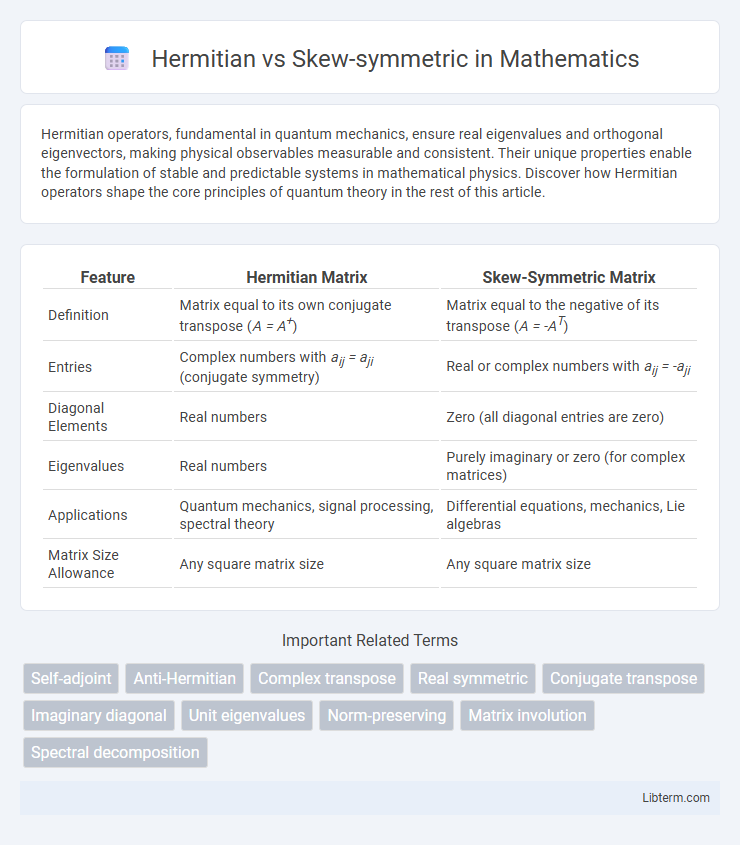Hermitian operators, fundamental in quantum mechanics, ensure real eigenvalues and orthogonal eigenvectors, making physical observables measurable and consistent. Their unique properties enable the formulation of stable and predictable systems in mathematical physics. Discover how Hermitian operators shape the core principles of quantum theory in the rest of this article.
Table of Comparison
| Feature | Hermitian Matrix | Skew-Symmetric Matrix |
|---|---|---|
| Definition | Matrix equal to its own conjugate transpose (A = A+) | Matrix equal to the negative of its transpose (A = -AT) |
| Entries | Complex numbers with aij = aji (conjugate symmetry) | Real or complex numbers with aij = -aji |
| Diagonal Elements | Real numbers | Zero (all diagonal entries are zero) |
| Eigenvalues | Real numbers | Purely imaginary or zero (for complex matrices) |
| Applications | Quantum mechanics, signal processing, spectral theory | Differential equations, mechanics, Lie algebras |
| Matrix Size Allowance | Any square matrix size | Any square matrix size |
Introduction to Hermitian and Skew-Symmetric Matrices
Hermitian matrices are complex square matrices that satisfy the property \(A = A^H\), where \(A^H\) denotes the conjugate transpose, ensuring all eigenvalues are real and the matrix is diagonalizable. Skew-symmetric matrices are square matrices \(B\) over real numbers such that \(B^T = -B\), implying all diagonal elements are zero and eigenvalues are purely imaginary or zero. Both Hermitian and skew-symmetric matrices play crucial roles in linear algebra, quantum mechanics, and vibration analysis due to their distinct symmetry and spectral characteristics.
Fundamental Definitions
A Hermitian matrix is a complex square matrix that is equal to its own conjugate transpose, satisfying the condition \( A = A^H \), where \( A^H \) denotes the conjugate transpose. In contrast, a skew-symmetric (or antisymmetric) matrix is a real square matrix that satisfies \( A = -A^T \), meaning it is equal to the negative of its transpose. The fundamental distinction lies in Hermitian matrices involving complex conjugation and symmetry, while skew-symmetric matrices pertain to real matrices with anti-symmetry and no conjugation.
Mathematical Representation
A Hermitian matrix \(H\) satisfies the condition \(H = H^\dagger\), where \(H^\dagger\) denotes the conjugate transpose, ensuring all eigenvalues are real and the matrix is equal to its complex conjugate transpose. In contrast, a skew-symmetric matrix \(A\) satisfies \(A = -A^T\), where \(A^T\) is the transpose, implying that all diagonal elements are zero and eigenvalues are purely imaginary or zero. Hermitian matrices are central in quantum mechanics due to their real spectra, while skew-symmetric matrices arise naturally in differential equations and rotations, highlighting a fundamental difference in their algebraic properties.
Key Properties and Characteristics
Hermitian matrices are square matrices equal to their own conjugate transpose, ensuring all eigenvalues are real and eigenvectors form an orthonormal basis, crucial for quantum mechanics and signal processing. Skew-symmetric matrices are square matrices with the property A^T = -A, leading to purely imaginary or zero eigenvalues and are essential in studying rotational transformations and differential equations. Both matrix types exhibit unique symmetry properties that influence their applications in physics and engineering, with Hermitian matrices tied to energy conservation and skew-symmetric matrices to angular momentum.
Eigenvalues and Eigenvectors Comparison
Hermitian matrices have real eigenvalues and orthonormal eigenvectors, ensuring stability and diagonalizability over the complex field. Skew-symmetric matrices possess purely imaginary eigenvalues or zero, with eigenvectors typically forming pairs corresponding to conjugate eigenvalues, reflecting antisymmetric properties. The spectral theorem applies directly to Hermitian matrices, while skew-symmetric matrices require complexification to analyze their eigenstructure fully.
Applications in Mathematics and Physics
Hermitian matrices, characterized by equal entries to their complex conjugate transposes, are pivotal in quantum mechanics for representing observable operators with real eigenvalues and orthonormal eigenvectors, ensuring measurable physical quantities. Skew-symmetric matrices, where the transpose equals the negative of the matrix, play a crucial role in differential geometry and classical mechanics, particularly in representing infinitesimal rotations through Lie algebras and antisymmetric tensors fundamental to angular velocity and electromagnetic fields. These distinct matrix structures enable precise modeling of symmetries and conservation laws across various mathematical frameworks and physical theories.
Differences in Matrix Operations
Hermitian matrices are equal to their own conjugate transpose, meaning \( A = A^H \), while skew-symmetric matrices satisfy \( A = -A^T \) without complex conjugation. In matrix multiplication, Hermitian matrices preserve positive definiteness and exhibit real eigenvalues, whereas skew-symmetric matrices have purely imaginary eigenvalues or zero, reflecting antisymmetric properties. Hermitian matrices produce symmetric bilinear forms under conjugation, contrasting with skew-symmetric matrices that produce alternating bilinear forms, influencing their behavior in quadratic forms and spectral decomposition.
Real-World Examples
Hermitian matrices are essential in quantum mechanics for representing observable properties like energy levels in atoms, where their complex conjugate symmetry ensures real eigenvalues. Skew-symmetric matrices appear in classical mechanics and robotics to describe rotational motion and angular velocity through antisymmetric properties. Both types of matrices provide critical mathematical frameworks in engineering and physics for modeling systems with symmetry constraints and conserved quantities.
Advantages and Limitations
Hermitian matrices provide real eigenvalues and orthogonal eigenvectors, making them essential in quantum mechanics and signal processing for stable and interpretable solutions. Skew-symmetric matrices have purely imaginary eigenvalues, which are useful in modeling rotational dynamics and preserving structure in systems like Lie algebras. Hermitian matrices are limited by symmetry constraints that may not model all physical phenomena, while skew-symmetric matrices cannot represent systems requiring real eigenvalues for stability analysis.
Summary and Final Insights
Hermitian matrices are square matrices equal to their own conjugate transpose, characterized by real eigenvalues and orthonormal eigenvectors, making them essential in quantum mechanics and signal processing. Skew-symmetric matrices, defined by the property that their transpose equals the negative of the matrix, possess purely imaginary eigenvalues and appear predominantly in physics and control theory. Understanding the distinction between Hermitian and skew-symmetric matrices is crucial for applications involving matrix diagonalization, stability analysis, and spectral properties in various engineering and scientific fields.
Hermitian Infographic

 libterm.com
libterm.com